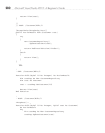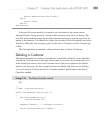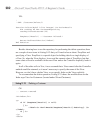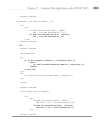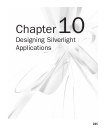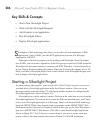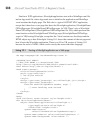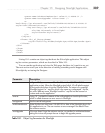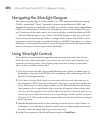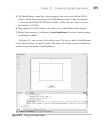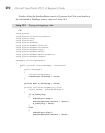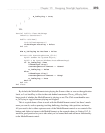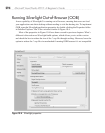
288 Microsoft Visual Studio 2010: A Beginner’s Guide
Similar to WPF applications, Silverlight applications start with a MainPage.xaml file
and an App.xaml file, where App.xaml runs to initialize the application and MainPage
.xaml contains the display page. The Web site is a typical ASP.NET MVC application,
except that it does have a test page that hosts the Silverlight application, SilverlightDemo
CSTestPage.aspx (SilverlightDemoVBTestPage.aspx for VB). There’s also a Silverlight
DemoCSTestPage.html (SilverlightDemoVBTestPage.html for VB), which performs the
same function as the SilverlightDemoCSTestPage.aspx (SilverlightDemoVBTestPage
.aspx for VB) hosting Silverlight, except that the *.html version uses JavaScript and the
HTML object tag to host Silverlight. Listing 10-1 shows the contents of the test page and
how it hosts the Silverlight application. There is no C# or VB version of Listing 10-1
because the code is XAML, which works exactly the same with either language.
Listing 10-1 Hosting a Silverlight application on a Web page
<%@ Page Language="C#" AutoEventWireup="true" %>
<!DOCTYPE html PUBLIC
"-//W3C//DTD XHTML 1.0 Transitional//EN"
"http://www.w3.org/TR/xhtml1/DTD/xhtml1-transitional.dtd">
<html xmlns="http://www.w3.org/1999/xhtml" >
<head runat="server">
<title>SilverlightDemoCS</title>
<style type="text/css">
// css styles omitted
</style>
<script type="text/javascript" src="Silverlight.js"></script>
<script type="text/javascript">
function onSilverlightError(sender, args) {
// error handling code omitted
}
</script>
</head>
<body>
<form id="form1" runat="server" style="height:100%">
<div id="silverlightControlHost">
<object data="data:application/x-silverlight-2,"
type="application/x-silverlight-2"
width="100%" height="100%">
<param name="source"
value="ClientBin/SilverlightDemoCS.xap"/>
<param name="onError" value="onSilverlightError" />
<param name="background" value="white" />



